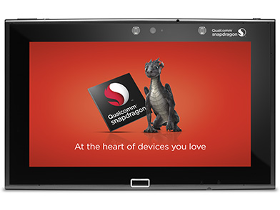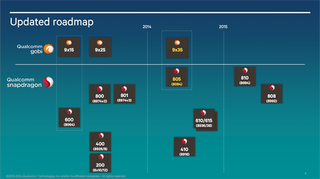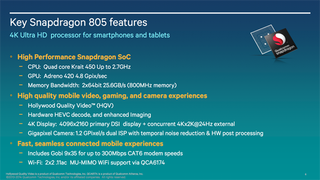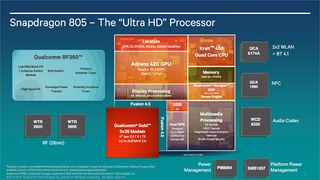Qualcomm Snapdragon 805 Performance Preview
The Snapdragon brand is synonymous with performance. It creates anxiety that competing SoCs feel deep down in their silicon substrate. But can Qualcomm's new Snapdragon 805 maintain its dominance in the Android-based smartphone market?

Snapdragon Becomes Snappier

By all accounts, Qualcomm’s Snapdragon processors are incredibly successful, powering over 1350 announced or available devices and, according to Strategy Analytics, garnering more than half of all smartphone SoC revenue in Q3 2013. The auspicious Snapdragon lineage started in 2008 when the Snapdragon S1 emerged from its lair with Adreno 200 graphics (based on technology acquired from AMD) and a Scorpion-based CPU core leveraging the ARMv7 instruction set. Manufactured on a 65 nm process and operating at clock rates as high as 1 GHz, Scorpion was a custom design based on the ARM Cortex-A8 reference architecture. In the years that followed, the Snapdragon S2, S3, and S4 were added to the family, each new SoC pushing the performance envelope further.
Then, in 2013, Qualcomm introduced a new CPU architecture named Krait and paired it with Adreno 3xx-series graphics to create the Snapdragon 400, 600, and 800 SoCs.
The top-performing Snapdragon 800 employs an Adreno 330 engine (450 MHz) and Krait 400 quad-core CPU at up to 2.26 GHz. Earlier this year, though, Qualcomm pushed frequencies even higher with its Snapdragon 801: 578 MHz for the GPU, up to 2.45 GHz for the CPU, and 465 MHz for the ISP (up from 320 MHz in Snapdragon 800).

Mobile is a highly competitive market, and for Qualcomm to remain a premier provider, it had to keep evolving. The newer Snapdragon 805 sports a faster Krait 450 CPU, a new Gobi 9x35 modem with support for up to 300 Mb/s LTE Advanced CAT6, and an improved ISP for purportedly better imaging. Company reps call this the first commercially available mobile SoC supporting a 4K viewing experience. To enable that, the 805 boasts an updated Adreno 420 GPU architecture along with significantly increased memory bandwidth.

CPU and Memory
The Krait 450 CPU in Snapdragon 805 is the final addition to the Krait family, and the last high-end 32-bit SoC on Qualcomm’s roadmap. We’ll have to wait for the Snapdragon 810's introduction in 2015 before we see a new 64-bit CPU architecture supporting the ARMv8 instruction set. So, there aren't any significant changes baked into Krait 450. It has four cores, each with a 4 KB + 4 KB L0 cache and a 16 KB + 16 KB L1 cache, complemented by a shared 2 MB L2 cache. The CPU is a custom design by Qualcomm (which, like Apple, has an architecture license for creating ARM ISA-compatible products) with some similarities to the ARM Cortex-A15.
But it’s interesting to note how Qualcomm’s approach to CPU design differs from both ARM and Apple (Nvidia and Samsung are ARM processor licensees; they haven’t introduced anything unique yet on the architecture front). With Krait, Qualcomm implements a narrower, simplified architecture with high clock rates. On the other hand, Apple’s Cyclone-based host processor in the A7 SoC appears more desktop-like in terms of execution width and complexity, but operates at much lower frequencies. Both IPC (instructions per cycle) throughput and frequency for ARM’s Cortex-A15 fall between Krait and Cyclone.
Krait features an out-of-order speculative issue (an optimization technique whereby the CPU uses branch prediction to guess the path a program may take and executes the instructions before they’re needed) superscalar execution pipeline with 11 integer stages, compared to the -A15's 15 stages. While the execution pipeline is out-of-order, the initial fetch/decode stages are in-order and instructions must also be retired in-order. Krait 450 can still fetch and decode three instructions per clock cycle, and execute up to four instructions in parallel. For comparison, Apple’s Cyclone design offers twice the IPC of Krait, fetching/decoding, executing, and retiring six instructions per cycle. Cyclone also has a larger instruction reorder buffer, holding up to 192 micro-ops versus 128 for the -A15 and only 40 for Krait, which, in theory, should allow for fewer stalls and more efficient use of its pipeline. Even though the Krait 450's architecture and IPC remain unchanged, it should still offer a small performance increase over Krait 400 thanks to a boost in maximum frequency from 2.45 to 2.65 GHz (Qualcomm’s advertised frequencies are rounded up to the nearest 100 MHz).
Stay on the Cutting Edge
Join the experts who read Tom's Hardware for the inside track on enthusiast PC tech news — and have for over 25 years. We'll send breaking news and in-depth reviews of CPUs, GPUs, AI, maker hardware and more straight to your inbox.
Right about now you're probably thinking that this situation sounds a lot like the transition from Snapdragon 800 to 801. So, why is the Krait brand incrementing for 805 when it retained its Krait 400 designation for 801? The answer begins with another question. Since Krait 450 reuses the same underlying architecture and 28 nm HPm process as Krait 400, how did Qualcomm boost its peak frequency again? Although we are unable to confirm this with Qualcomm, it’s likely that the circuit traces on the die have been optimized. With a new die comes a new designation.

While Snapdragon 805 doesn’t offer any alluring CPU performance gains, it does provide a substantial memory bandwidth increase. The 805 SoC pairs a 32-bit quad-channel bus with LPDDR3-800 memory for a peak throughput of 25.6 GB/s. That's twice the maximum bandwidth of Snapdragon 800 (12.8 GB/s) and about 70% more than Snapdragon 801 (14.9 GB/s). It’s also more than Apple’s A7. It actually approaches what a fairly modern desktop CPU's integrated memory controller can do. All of this extra memory bandwidth isn’t for the CPU, though. It's reserved for Qualcomm’s new Adreno 420 GPU.
Current page: Snapdragon Becomes Snappier
Next Page Snapdragon 805: GPU And The 4K Revolution-
blackmagnum Trying not to be an Apple fanboy, but their A7 processor supports 64-bit instructions since last year. They lead innovation due to their clientele having more open-ended budget for the device than Android users (can't remember link to the study).Reply -
JOSHSKORN Did I read that right? There won't be ANY 64-bit Android Phones until 2015? It's going to take practically TWO YEARS to play catch-up to the iPhone? Mind you, most iPhone users don't know the difference between 32-bit and 64-bit, anyway, but it's "better" and that their logic for upgrading. Preying on stupid people basically has become (or always has been?) Apple's business model, and it's paid off. Sometimes, I wish I wasn't anti-Apple. C'mon, Android...get with the program!Reply -
rantoc Just find it funny tragic that more and more phone displays are almost at the same resolution as in many general desktop PC's.Reply
Also find it funny that their marketing team dare to call this "Ultra HD", would be fun to see a benchmark of this running that 4k resolution in any 3D descent detail benchmark=P
"It actually approaches what a fairly modern desktop CPU's integrated memory controller can do. All of this extra memory bandwidth isn’t for the CPU, though. It's reserved for Qualcomm’s new Adreno 420 GPU."
Yeah mostly is for the GPU, where a modern PC gpu alone pushes well over 300gb/sec. Close no? =P -
Memnarchon Dam! And I was hoping to see K1 on these benchmarks too, for a comparison. Oh well...Reply -
ta152h Is it too difficult for you guys to write a consistently good and accurate article? It's like you do the hard stuff, and then screw up details.Reply
For example, why are some charts from 0 to somewhere above the max score, and others start at, for example, 2300 and go to 3000.
I realize you guys aren't really computer people from this terrible lack of attention to detail (which someone who does more than write about computers has to have as a personality flaw), but can't you hire someone that can look over this stuff, and at least try to present it in a consistent way? Writers who aren't computer people make these types of mistakes, because their minds aren't ordered enough, but you guys really need someone like that, because all the articles suffer from imprecision and lack of clarity (and over use of words like 'alacrity', which really implies emotion, and isn't a true synonym for speed. Again, precision ...)
For example, I'm looking at charts, and am shocked by some, then realize it's just because you guys screwed up the scaling, and can't stay consistent.
Don't worry, a chart that shows very little difference because you used the full scale isn't bad. Because, if you really think about it, neither is the performance, and if you can't see a big difference in the chart, you aren't going to see a big difference in the performance. But, when you see one bar over three times longer than another, and the real difference is less than 20%, don't you think that gives the wrong impression?
If you do all the hard work, and then screw up details, it's just not as good as it could be. And yes, I've learned these sites like to say things in a way it is correct, but then present it in a manner which gives the opposite impression. Try writing without bias, and maybe this will go away. Charts are one way, comparing Kabinis with Haswells are another. Commenting more on charts that read what you want, while just presenting charts you don't like the results of, are another way. Or commenting on the part of the chart you like, while ignoring the part you don't. It's not as subtle as you might think, or maybe it is, and you don't even realize your bias. But we do.
I used to love this site, especially when Thomas Pabst used to write in his crazy way. But, it's slowly, and inexorably getting worse. There are better sites now. Maybe skip the really bad car reviews (do you really think your opinions even approximate professional sites like Car and Driver? At all? ) and focus more producing better quality computer articles. It should be easy, you guys get a lot of good information, often do reviews that people want but other sites skip, but then screw it up with a lack of attention to detail and consistency.
-
esrever I find the inconsistency makes most of this completely pointless until the software gets actually optimized and the drivers start working.Reply -
hannibal Well I really expect new article in near future where Tegra K1 and 805 are against each other. And then 810. It is interesting to see what 64bit computing will bring to mobile platforms... Mobile gaming is getting quite serious in next few years!Reply
-
irish_adam I dont see why you are all so impressed with 64bit. I mean if you believe that the A7 is super amazing because it is 64bit then you're an idiot. The fact that its 64bit adds minimal performance and is 100% gimmick and just so that they can claim to be the first.Reply
It reminds me of when AMD released their first 64bit chips and microsoft released XP64, you soon realised that unless you had 4gb or more of ram then there was no difference (well except that none of your hardware drivers would work grrrr).
Why would Qualcomm rush out a 64bit chip when there isnt any real improvement to be had? surely its better that they focus on things that will actually improve performance and battery life? I mean they havent even finished a 64bit version of android yet so what would it even run on? Until we see the need for more than 4gb of ram on phones then i really dont see the point
Most Popular


